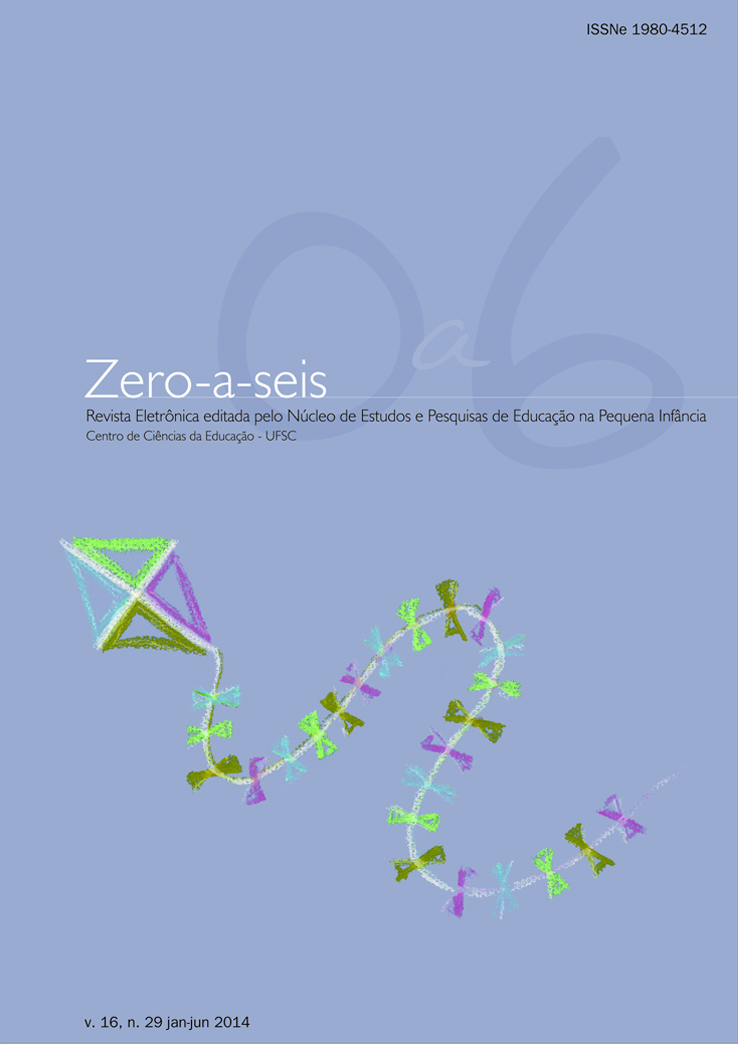Mapping attributes of creativity in brincantes activities For children from five to seven years
DOI:
https://doi.org/10.5007/1980-4512.2014n29p84Abstract
The aim of this study was to map attributes of creativity manifested by children five to seven years in brincantes activities in the Program for the Eradication of Child Labor City Jacarézinho, state of Paraná. The study was based on the research literature and field, including the Planning and Implementation of Activities Brincantes, the Participant Observation; Debate with Teachers , Staff and direction Pedagogical PETI, and the records in Field Journal . The activities have been planned and implemented for a group of twenty-five children of both sexes in the period March-July 2011, totaling thirty meetings of one hour each, twice a week. For the purposes of classification, the activities proposed and developed brincantes were divided into eight groups. They are: 1) Play sung, accompanied by choreography; 2) Games; 3) Rhythmic Activities; 4) Reproductions; 5) Plastic compositions; 6) Gymnastics; 7) Old Joke, 8) Storytelling. These activities were highlighted, attributes of creativity, such as the formation of ideas or hypotheses, hypothesis testing , and reporting results, the ability to see and understand things, originality, complexity, surprise, unpredictability, curiosity, inventiveness, imagination, discovery, exploration, experimentation, creating something new. Were also prominent characteristic of playfulness in activities such as the imaginary situation, imitation and rules. It was concluded that brincantes activities are fundamental for the development of these children in order to allow the expansion of personal experience. Furthermore, it is concluded that the theory of Vygotsky, particularly with regard to the formation of concepts, mediation and immediate development area, are in important fundamentals to address the relationship between creativity and brincantes activities.References
BARTLETT, F. Thinking. New York: Basic Books, 1958.
BERLYNE, D.E. Aesthetics and Psychobiology. New York: Appleton-Century-Crofts, 1971.
CERISARA, Ana Beatriz. De como o Papai do Céu, o Coelhinho da Páscoa, os Anjos e o Papai Noel foram viver juntos no céu! In: KISHIMOTO, Tizuko Morchida. (Org.). O brincar e suas teorias. São Paulo: Cengage Learning, 2010.
CORSARO, Willian. Entrada no campo, aceitação e natureza da participação nos estudos etnográficos com crianças pequenas. Educação e Sociedade. Campinas, v. 26, n. 91, 2005.
FERREIRA, Maria Manuela Martinho. “- A gente aqui o que gosta mais é de brincar com os outros meninos!” – as crianças como atores sociais e a (re) organização social do grupo de pares no cotidiano de um Jardim de Infância. Dissertação de doutoramento em Ciências da Educação, Universidade do Porto, Faculdade de Psicologia e Ciências da Educação. 2002.
GUILFORD, Joy Paul. Factors That Aid and Hinder Creativity. In: GOWAN, John Curtis; DEMOS, George D.; TORRANCE, Ellis Paul et alii. Creativity: Its Educational Implications. USA: John Wiley & Sons, 1967.
MARTINDALE, Colin. Como podemos medir a criatividade de uma sociedade? In: BODEN, Margaret A. (Org.). Dimensões da criatividade. Porto Alegre: Artes Médicas Sul Ltda., 1999. p. 166-201.
PARRAT-DAYAN, Silvia. Gênio e Criatividade. In: VASCONCELOS, Mário Sérgio. (Org.). Criatividade: Psicologia, Educação e Conhecimento do novo. São Paulo: Moderna, 2001. p. 113-124.
RIBOT, Théodule Armand. Essai sur l’imagination créatice. Paris: F. Alcan, 1900.
SARMENTO, Manuel. Gerações e alteridade: interrogações a partir da Sociologia da Infância. Educação & Sociedade. (Dossiê Temático Sociologia da Infância: pesquisas com crianças). CEDES- Brasil, v. 26, n.91, p.361-273, 2005.
TORRANCE, Ellis Paul. Why Fly?: A Philosophy of Creativity. New Jersey, EUA: Ablex Publishing Corporation, 1995.
VIGOTSKI, Lev Semenovich. Imaginação e criação na infância: ensaio psicológico. Apresentação e comentários de Ana Luiza Smolka. Tradução de Zoia Prestes. São Paulo: Ática, 2009.
VIGOTSKI, Lev Semenovich. A construção do pensamento e da linguagem. Tradução de Paulo Bezerra. 2. ed. 2. tiragem. São Paulo: WMF Martins Fontes, 2010.
Downloads
Published
Issue
Section
License
As pessoas autoras cedem à revista Zero-a-Seis os direitos exclusivos de primeira publicação, com o trabalho simultaneamente licenciado sob a Licença Creative Commons Attribution (CC BY) 4.0 International. Esta licença permite que terceiros remixem, adaptem e criem a partir do trabalho publicado, atribuindo o devido crédito de autoria e publicação inicial neste periódico.
As pessoas autoras têm autorização para assumir contratos adicionais separadamente, para distribuição não exclusiva da versão do trabalho publicada neste periódico (ex.: publicar em repositório institucional, em site pessoal, publicar uma tradução, ou como capítulo de livro), com reconhecimento de autoria e publicação inicial neste periódico.



